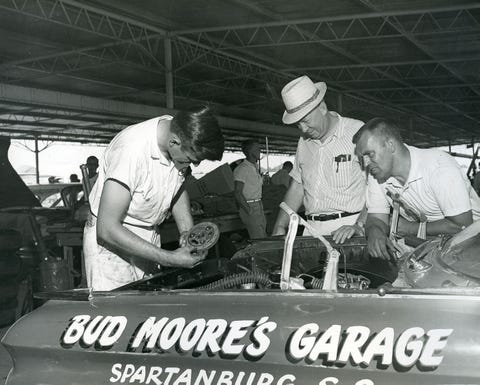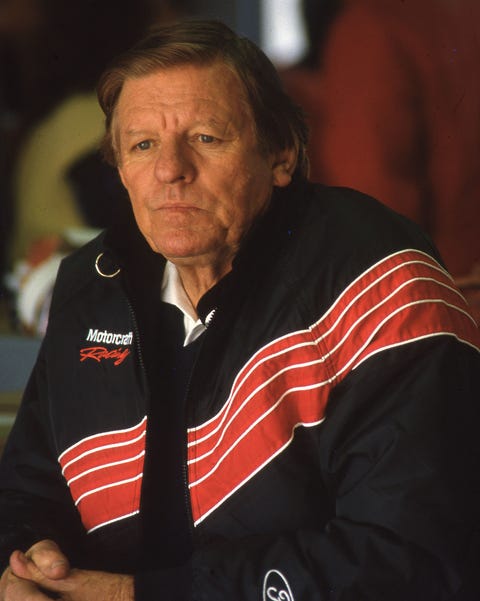
For most fans, Monday, June 6 probably passed like most Mondays during the NASCAR season.
They debated the Ross Chastain vs. Everybody bruhaha from St. Louis. They enjoyed reviewing Joey Logano’s overtime victory over Kyle Busch at World Wide Technology Raceway. And they admired how AJ Allmendinger had won the Saturday afternoon Xfinity race in Oregon and finished 10th in the Sunday afternoon Cup race in Illinois.
It’s safe to say that some might have even recalled 78 years ago, at dawn, in June of 1944, on the shores of northwestern France.
There, an 18-year-old private from Spartanburg, S.C. named Walter “Bud” Moore and his water-cooled machine gun waded ashore at Utah Beach as the world’s grandest military force invaded Europe to begin the end of World War II. The future NASCAR team owner and 2011 Hall of Famer inductee was with Company D, 1st Platoon, 1st Battalion, 359th Infantry Regiment of the 90th Infantry Division at Normandy on D-Day.
“It was some kind of experience, I’ll tell you that,” Moore, who died in 2017 at age 92, said years later at the NASCAR Hall of Fame. “They took us out two days earlier for what they said was going to be a dry run landing on an English beach. But when I saw those 5 or 6,000 ships as far as the eye could see I told some of my buddies, ‘Boys, I can tell you one thing: This ain’t no dry run. This is the real thing.’ I’d never seen the likes of that many ships.”
Moore recounted how he almost drowned because the sailor piloting his landing craft didn’t get close enough to the beach. Instead of getting within 150 yards of sand, the door dropped at 200 yards. “It was supposed to be knee-deep water, but it was shoulder-high,” he said. “I had a 51-pound backpack and a machine gun tripod, and I stepped in a shell hole and went under. I finally got myself out, then spent time up against a sand dune spitting water and clearing my eyes. I looked around and couldn’t believe what was going on. War is war and war is hell… I can tell you that.”
He went inland with Gen. George Patton, headed toward Paris. He spent nine uninterrupted months on the front lines, sweeping relentlessly across France and into Germany. “We killed everything that moved,” he said. “Men, women, soldiers, kids, animals. That’s just the way it was. But the Germans would have done the same thing.”
Moore was awarded two Bronze Stars for heroic actions and five Purple Hearts for combat-related wounds. The first Bronze was for staying on the front lines for nine months without a break. The second came when he and his driver captured 19 Germans hiding in a regimental headquarters building during the Battle of the Bulge. In addition to Normandy and the Battle of the Bulge, he was honored for being part of the Siege of Bastogne.
He was discharged late in 1945 as a sergeant. He returned to Spartanburg, married long-time girlfriend Betty, and went into business selling and repairing cars. He once described himself as a “country mechanic who loved to make ’em run fast.” But he never seriously raced himself, preferring to work under the hood than in the cockpit.
When NASCAR got up and running in the late 1940s, he began fielding cars for local drivers. He was crew chief for 1957 champion Buck Baker. He started his own Grand National company (now Cup Series) in 1961 and promptly won the 1962 and 1963 championships with Joe Weatherly. He also was involved with SCCA Trans-Am and NASCAR Grand American racing. He has been honored by every significant motorsports Hall of Fame in the country.
Over time, Bud Moore Engineering won 43 poles and 63 Cup Series races between 1961 and 2000, mostly in Ford products. He fielded cars for such stars as Weatherly, Buck and Buddy Baker, Bobby and Donnie Allison, Dan Gurney, Parnelli Jones, Benny Parsons, Tiny Lund, David Pearson, Fireball Roberts, Ricky Rudd, Dale Earnhardt, Darrell Waltrip, Cale Yarborough, Rex White, Geoffrey Bodine, and Bobby Isaac.
During his 2011 Hall of Fame speech, Moore described himself as “One who made many contributions to the sport; whose firm handshake was as good as any contract; and who always gave a straight answer. Most of all, to be remembered as a man who loved his family, his country, and the sport of racing.”
Nobody could have said it better—or been a better credit to the sport.
This content is created and maintained by a third party, and imported onto this page to help users provide their email addresses. You may be able to find more information about this and similar content at piano.io


